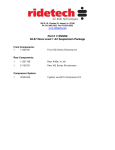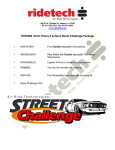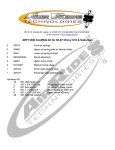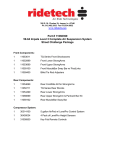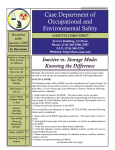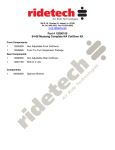Download - RideTech.com
Transcript
350 S. St. Charles St. Jasper, In. 47546 Ph. 812.482.2932 Fax 812.634.6632 www.ridetech.com Part # 11257199 62-67 Nova Rear AirBar Components: 1 90002077 1 90002078 1 90000535 1 90000536 2 90000144 2 90000524 1 90000539 1 90000540 2 90000533 1 90000537 2 90001001 2 90001030 2 99250001 4 90001085 4 90000538 2 90001589 2 99752004 4 90000552 4 90001942 2 90002285 2 70010694 Lower axle bracket - Driver Lower axle bracket - Passenger Lower shockwave mount Lower shockwave mount Axle tabs Axle tabs Upper bar mount Upper bar mount Upper bar bolt plate Upper cross member Upper bar – TW 7.375” (C-C length 9.50”) Lower bar – WW 25.00” ¼”-28 straight grease fitting Poly bushing halves for lower bar Lower bar bushing sleeve Threaded Kevlar lined Heim end ¾”-16 jam nut – for rod end Aluminum spacer for Heim end Rubber bushings pressed into bars Square corner U bolt - Upper cross member to car Jig brackets for upper bar installation Hardware Kit: (Part # 99010018) 6 5/8”-11 x 2 ¾” Gr.5 bolt 6 5/8”-11 Nylok jam nut 12 3/8”-16 Nylok nut 12 3/8” SAE flat washer 4 1/2"-13 x 2 ¼” Gr.5 bolt 4 1/2"-13 Nylok jam nut 4 5/8”-11 x 1 ¼” Gr.5 bolt 4 5/8”-11 Nylok nut 8 7/16”-20 Nylok nut 2 3/8”-16 x ¾” Gr. 5 bolt 2 3/8”-16 nut Bars to cross member and brackets Bars to cross member and brackets Upper bar mount and cross member Upper bar mount and cross member Shockwaves to mounts Shockwaves to mounts Shockwave brackets to axle brackets Shockwave brackets to axle brackets U-bolts Upper bar installation jig Upper bar installation jig 1. Raise the vehicle to a safe and comfortable working height. Use jack stands to support the vehicle with the suspension hanging freely. 2. Support the axle and remove the leaf springs, shocks, pinion snubber, and tail pipes. Refer to the factory service manual for proper disassemble procedures. Keep the factory upper shock bolts and front leaf spring mounting bolts. 1. The pinion snubber mount must be cut on the line shown in the picture. This allows more clearance of the pinion for maximum drop. 2. Remove the gas tank sending unit wire from the tank and pull it into the trunk. 3. This raised area around the gas tank sending unit wire must be flattened to allow the upper bar mount to sit against the pan. The area marked in chalk can either be pie cut, hammered flat and welded back together or cut out completely. 2 4. The upper bar mount will bolt to the bottom of the car using the factory shock bolts and locates off the factory shock mount. Note: The bar mount will point towards the outside of the car. This is the passenger side. 5. Using the bracket as a template drill 4 7/16” holes through the pan. 6. The upper bar bolt plate can be dropped into place from the trunk. The bracket will be clamped into place using 3/8” nylocs and flat washers. 7. Lower the axle enough to slide the upper crossmember into place. The frame is wider towards the rear of the car as is the crossmember. Push it forward until it is tight between the frame rails, but make sure it is square. Drill two holes with a 7/16” drill bit. 3 8. Remove the crossmember and drop the 3/8” U-bolt through the holes. Reinstall crossmember and tighten with 3/8” nylocs and flat washers. Shown below: 9. Bolt the lower axle bracket to leaf spring plate on the bottom of the axle using the new 7/16” nylocs supplied. Do not tighten until the lower bar is in place. 10. Install the lower arm (the longer one) into the oem leaf spring hanger using the factory hardware. This is a polyurethane bushing and is lubricated at the factory with lithium grease. Any future lubrication can be done with any nonpetroleum based lubricant. 11. The other end of the lower bar will attach to the axle bracket using 5/8” x 2 3/4" bolts and nylocs. This is a rubber bushing and does not require lubrication. Do not tighten the bar bolts yet. 12. The lower Shockwave mount is bolted to the lower two holes of the axle bracket with two 5/8” x 1 1/2" bolts and nylocs The U shaped portion of the bracket will face toward the inside of the vehicle. 13. Bolt the axle tabs to the upper bar as shown in the picture. Then bolt the other end to the upper bar mount. Do not weld the tabs yet. 14. Before welding the tabs you must center the axle and set the pinion angle. This must be done at ride height. Raise the axle until the is 14 1/2" from center eye to center eye on the Shockwave mounts, this is ride height. One trick that we use to maintain the settings are to tack weld a 4” spacer between the axle and the frame. 4 15. How do you set the pinion angle? On a single-piece shaft you want to set it up where a line drawn through the center of the engine crankshaft or output shaft of the transmission and a line drawn through the center of the pinion are parallel to each other but not the same line. A simple way to do this is to place a digital angle finder or dial level on the front face of the lower engine pulley or harmonic balancer. This will give you a reading that is 90 degrees to the crank or output shaft unless you have real problems with your balancer. At the other end, you can place the same level or angle finder against the front face of the pinion yoke that is also at 90 degrees to the centerline. If you rotate the yoke up or down so both angles match, you have perfect alignment. Road testing will tell you if you have it right. If you accelerate and you get or increase a vibration, then the pinion yoke is too HIGH. Rotate it downward in small increments of a degree or two until the problem goes away. If you get or increase a vibration when decelerating, then the pinion yoke is too LOW. Rotate it upward to correct it. 5 16. Axle center is best determined by dropping a plum on the outside of the quarter panel and measuring into the axle. This must be done with the car level from side to side. 17. Once everything has been doublechecked you can tack weld the tabs the axle. After removing the upper bar from the tabs you can finish welding the tabs. This will prevent you from frying the bushings. 18. Reinstall the upper bar and snug all bar bolt with the axle still at ride height. The 4” spacer can now be removed. 19. A new 3/4" hole must be drilled for the sending unit wire. You can reuse the original grommet. 20. Apply thread sealant the air fitting and screw it into the top of the Shockwave. 21. The Shockwave will be secured into place with 1/2" x 2 1/4" bolts and nylocs. 22. Check clearance with brake lines, parking brake and vent tubes. 23. The exhaust can either be rerouted under the axle or a turn down can be installed. 6 Upper Bar Installation Jig • • • • • • • • • • • This jig has been supplied to aid in the installation of the upper 4 link bar. It can be temporarily used to properly align, locate and weld the tabs onto the axle. It will also ensure that the mounting bolts are parallel to the ground. Follow the diagram below to set the jig to the same length as the upper bar, use the 3/8” x 3/4” bolt and nuts to set the length. Position the axle at ride height. Center the axle left to right between the quarter panels. Set pinion angle. Bolt one end of the jig to the cradle using a 5/8” x 2 ¾” bolt. Using another 5/8” x 2 ¾” bolt, fasten the axle tabs to the other end. The tabs must be bolted to the outside of the jig. Swing the bar down letting the tabs rest onto the axle. Trim the brackets as necessary to minimize the gap to be welded. Check pinion angle, ride height and axle center. Tack-weld the tabs in place. Remove jig and install upper bar. Repeat this process for the other side. Recheck pinion angle, ride height and axle center. (Sound familiar?) After the tabs have been tack welded on both sides, remove the upper bars to avoid melting the rubber bushings. Let the axle drop down for better access to the tabs. Lay 1” welds on the inside and outside of the tabs. Skip around from one side to the other to avoid overheating the tube. Item # Description 1. Upper bar 2. 3/4”-16 jam nut 3. Heim end 4. Alignment jig 5. Aluminum spacer 6. 5/8”-11 x 2 ¾” bolt 7. 3/8”-16 nut 8. 3/8”-16 x 3/4" bolt 7 350 S. St. Charles St. Jasper, In. 47546 Ph. 812.482.2932 Fax 812.634.6632 www.ridetech.com Should I weld my AirBar 4 link assembly in? Since we get this question quite often, it deserves a proper explanation. The AirBar has been designed for bolt-in installation. We have paid special attention to interfacing with key structural areas of each vehicle, fastening bracketry in at least two planes to properly distribute load paths, and to using appropriate fasteners that roll, rather than cut, threads into the vehicle structure. Having said that, you could potentially encounter a vehicle that has rust or collision damage in these areas. Or maybe you intend to consistently place the vehicle in severe racing applications with sticky racing slicks and high speed corners. In these cases it is perfectly acceptable to weld the AirBar components into your vehicle. Even in these severe cases we recommend that you install the entire AirBar assembly first [including the fasteners], and then use short 1” long tack welds to secure your installation. Remember that the vehicle structure metal is typically much thinner [.060”.120” ] than the .188” thick AirBar brackets. If you burn through the vehicle sheet metal structure you may end up with an installation that is weaker than before you tried to weld it. The other reason to weld in your AirBar assembly is…you simply want to. You’re a welding kind of guy…that’s the way you’ve always done it…you have the skills and equipment to do it. In that case…weld away with our blessing! 8








